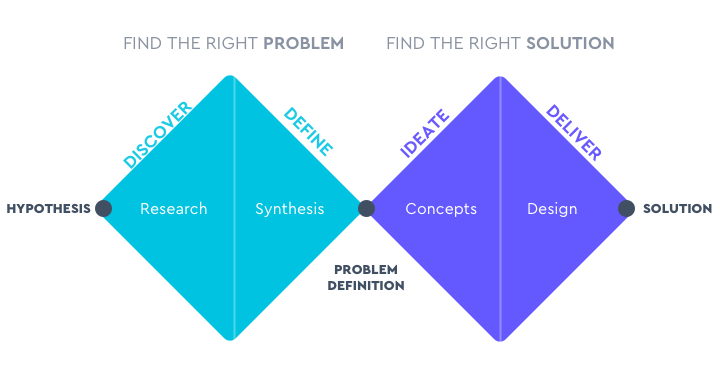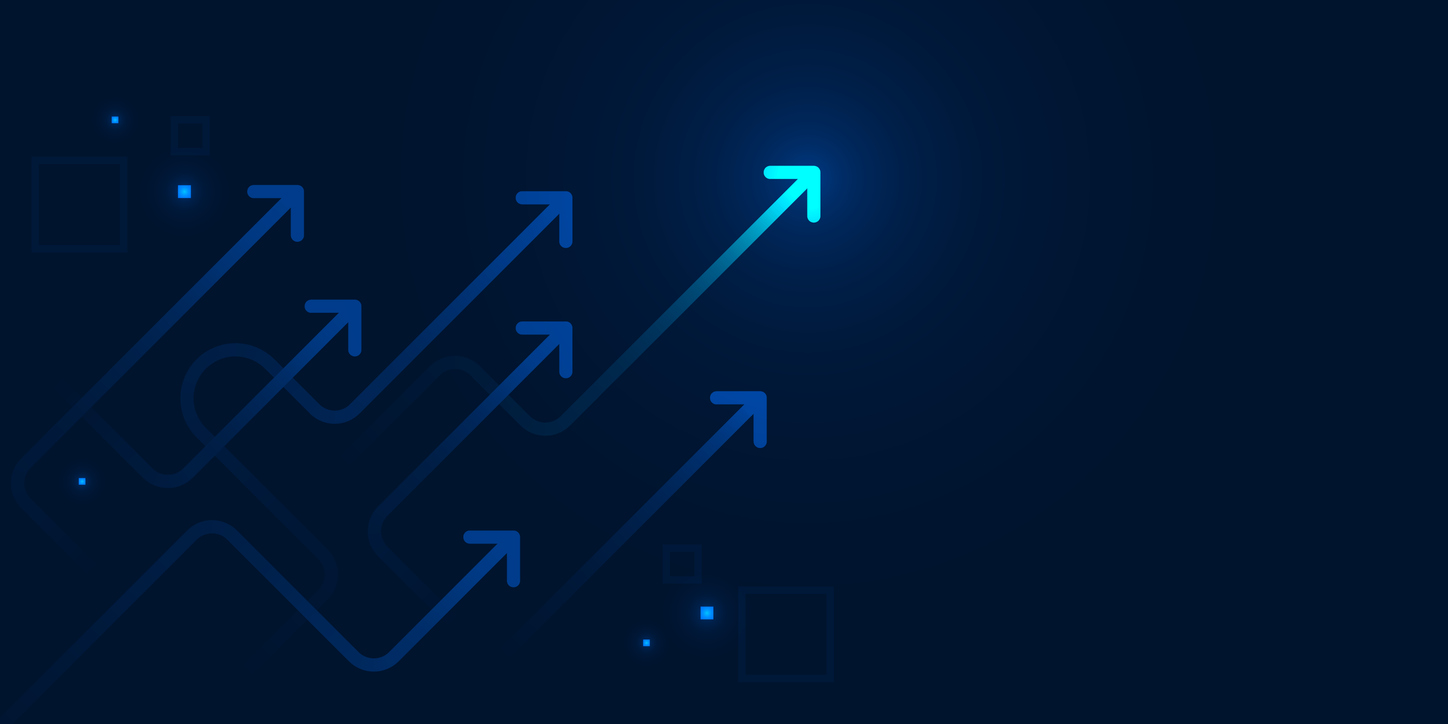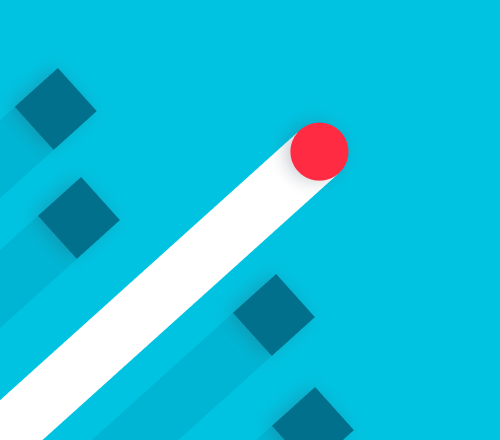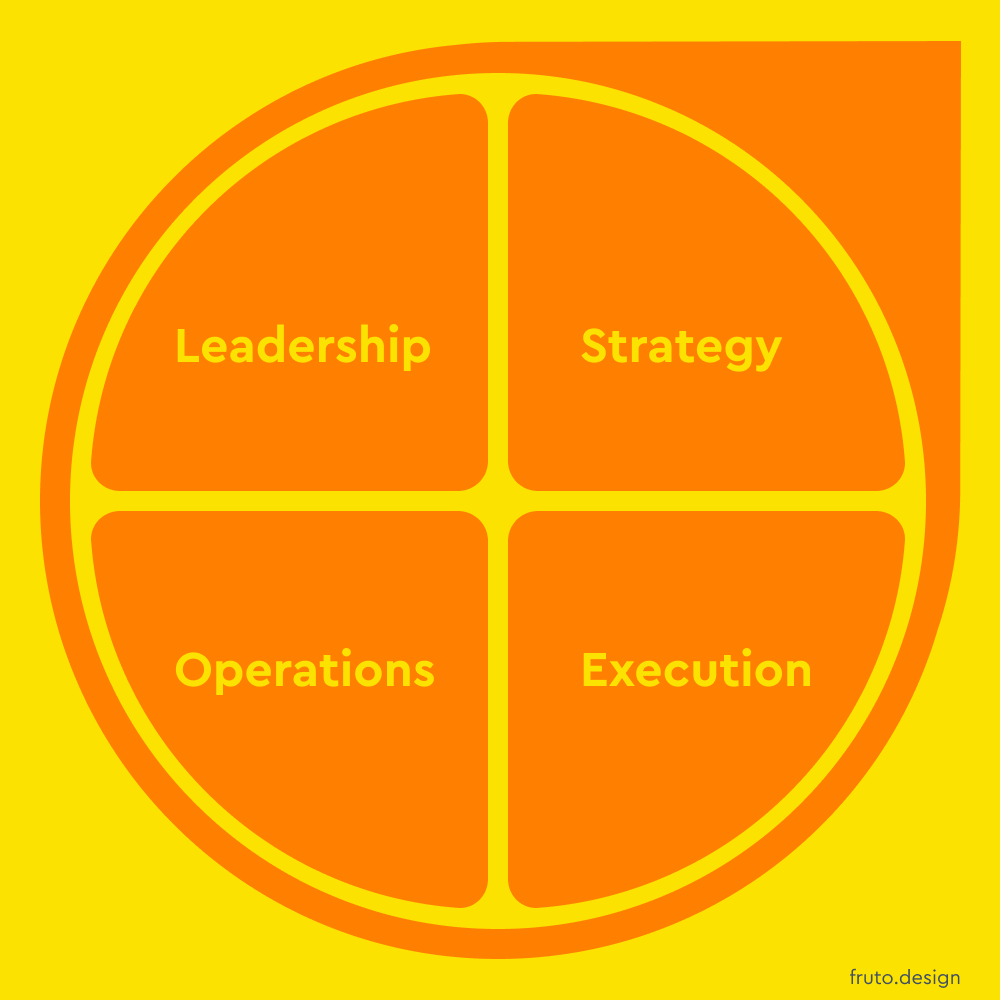Are you solving the right problem?
In product teams, it’s easy to fall in love with an idea, a feature, or a piece of tech. But you can’t achieve your outcomes if you’re solving the wrong problem. Are you solving the right problem?
Every strong product starts with clarity:
Find the right problem.
Then find the right solution.
The cost of building the wrong thing
Building the wrong thing is costly. When products are driven by assumptions rather than evidence, even the most talented teams can end up investing months of effort in something users don’t actually need nor value.
Without validating real customer needs, you risk:
Building something technically impressive but irrelevant. The product works, but it solves the wrong problem.
Polishing the wrong thing instead of fixing the right one. Effort goes into surface improvements rather than addressing the root cause.
Damaging customer trust and loyalty. Users lose confidence when updates make their experience worse or fail to address their real pain points.
Wasting time, budget, and opportunity. Every sprint spent building the wrong feature is a sprint not spent creating value or competitive advantage.
The result isn’t just wasted effort, it’s lost momentum. In fast-moving markets, that gap is all your competitors need to pull ahead.
Remaining competitive in the AI era
With the rise of AI and vibe coding, the barriers to entry in digital product development are lower than ever. Anyone can build fast.
The real question is: who will stand out? How can you ensure you remain competitive in the market? What will make a difference?
Success in tech businesses will depend on:
Market reach (reaching your customers). Products that reach customers through network effects or partnerships are more likely to succeed because it is more difficult for others to enter that market.
Value to customers (converting and retaining customers)
Market adaptation (remaining relevant and meeting customer needs). How quickly you adapt your product to real needs and the ever-changing environment
In the era of AI and rapid product imitation, differentiation won’t come from who builds fastest but from who delivers the most value to their customers.
Reducing risk through research
Avoid assumptions before you build. Don’t ask users what they want; understand what they need.
At Fruto, we use research methods such as:
Ethnographic research – observing people in their natural contexts to uncover unspoken behaviours and pain points.
User interviews – revealing motivations and frustrations that data alone can’t show.
Analytics – identifying patterns of use, drop-offs, and engagement to guide priorities.
Usability tests – exposing friction points early before they scale.
Discovery research saves countless cycles of rework and misalignment later on. It ensures every decision, from strategy to interface, serves both business goals and the real user and customer needs.
Based on the customer research:
Insights on their current solution, their current workflow and how you can provide improvements to that (Value curve mapping, User journey mapping). Every design is a redesign.
Insights into the nuances of their specific needs and what will make a difference to them.
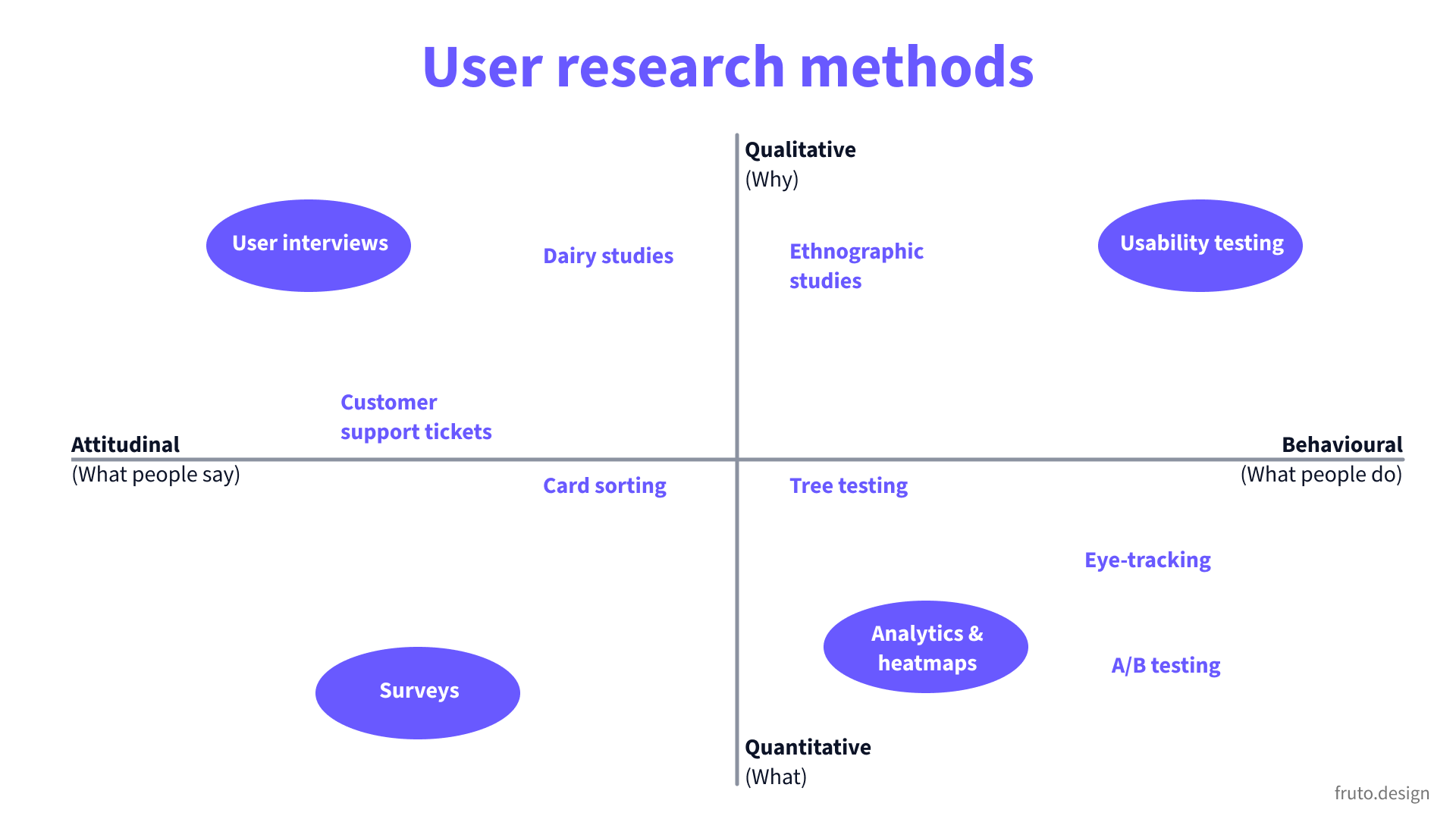
Every design is a redesign
I believe that every design is a redesign. Even when we’re creating something entirely new, users are already solving that problem in some way, whether through other tools, spreadsheets, or messy workarounds. They already have a process, however imperfect.
Our job as designers and strategists is to deeply understand those existing workflows and behaviours: what’s working, what’s painful, and what’s being patched together out of necessity.
Only then can we create something that genuinely improves on what came before, simplifying tasks, removing friction, and adding real value.
Good design doesn’t start from a blank page. It starts from empathy with what already exists and the courage to make it better in a meaningful way.
Opportunity journey mapping
Once you’ve gathered insights through discovery research (understanding user behaviours, workflows, motivations, and pain points) the next step is to make sense of them in context. This is where opportunity journey mapping becomes an incredibly valuable tool.
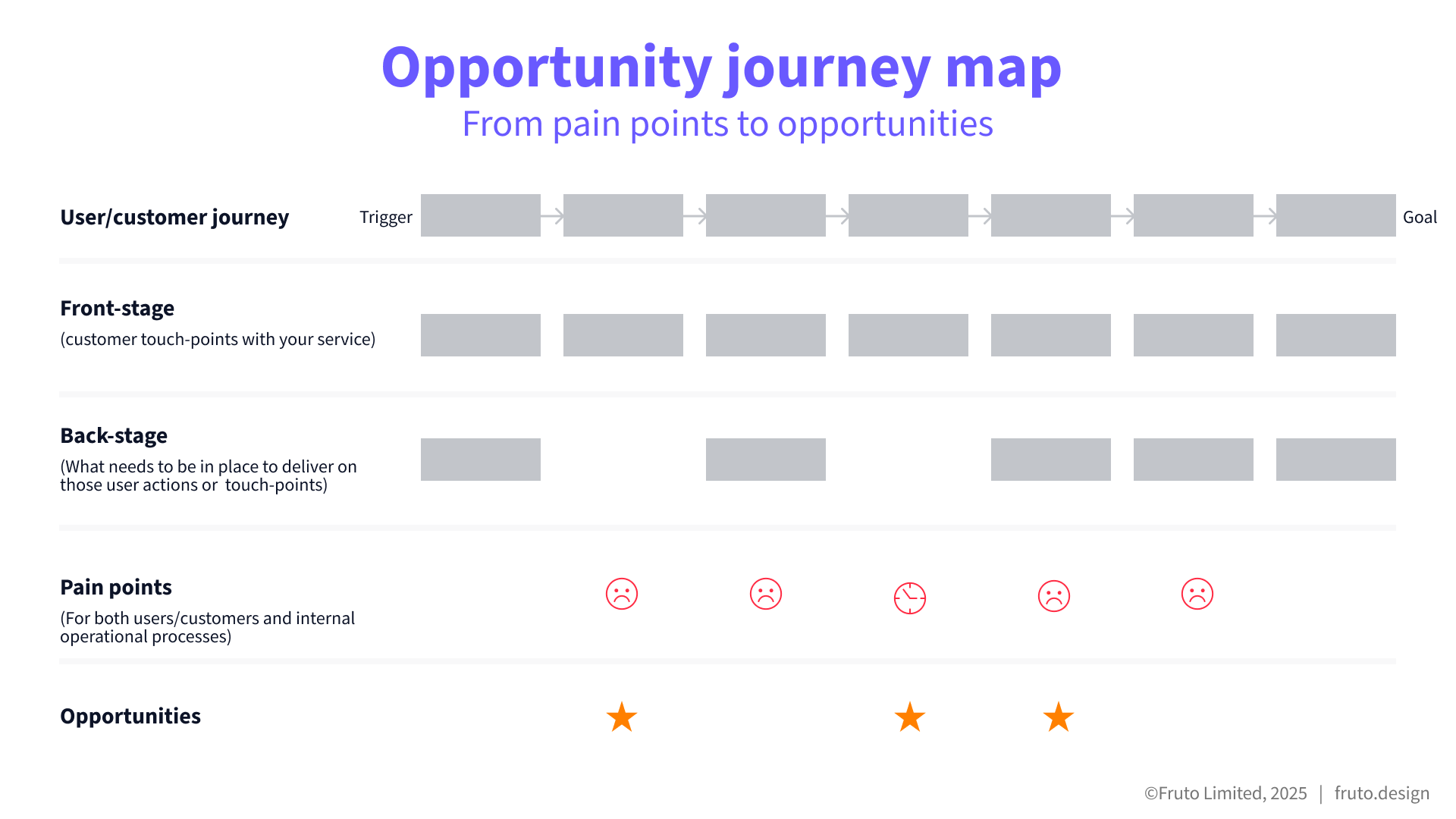
Opportunity customer journey map
The image in the presentation illustrates a hybrid of a user journey map and a service design blueprint, with an added layer of opportunities. Each project might have slightly different layers depending on its goals, but the purpose is always to bring clarity to the end-to-end workflow of the user or customer.
At the top sits the user journey, from the initial trigger through to the goal, showing the steps a person takes to complete a task or achieve what they need. This could represent how users interact with your current product, or, if you’re developing something new, how they’re already meeting that need through other tools, processes, or workarounds.
Next comes the front stage layer. The customer touchpoints with your service or product at each step of the journey. Beneath that, the backstage layer visualises what needs to be in place behind the scenes to support those interactions.
We then add layers for pain points —the moments of friction for users/customers — and, depending on the project, for internal teams too. Finally, we identify opportunities where improvements, innovations, or efficiencies could be made.
By layering these perspectives together, you gain a clear, visual understanding of how people actually get things done today and where your product or service can enhance that experience.
The benefit is focus. Opportunity journey mapping helps you see where to invest effort for the biggest impact, revealing the gaps, inefficiencies, and unmet needs that are ripe for improvement. It connects research insights to action, guiding design and product teams toward opportunities that truly matter.
Value curve mapping
From discovery research, we identify the factors customers genuinely value, the criteria they use to judge and compare products in your category. Once we understand these, we use value curve mapping to visualise how well your product currently meets those expectations and identify opportunities for differentiation.
A value curve is a simple but powerful way to plot how your product or service performs across key attributes, such as configurability and price, compared to competitors or existing alternatives. It’s not just about what your product does, but how it delivers value from the customer’s point of view.
When we map out these factors, clear patterns emerge. You can see where:
You’re investing effort in areas that customers don’t value as much.
You’re falling short in aspects that matter most to them.
There’s space to create new value that your competitors aren’t addressing.
Once it's mapped, the next step is to decide what to increase, reduce, eliminate, or create. This is where innovation happens.
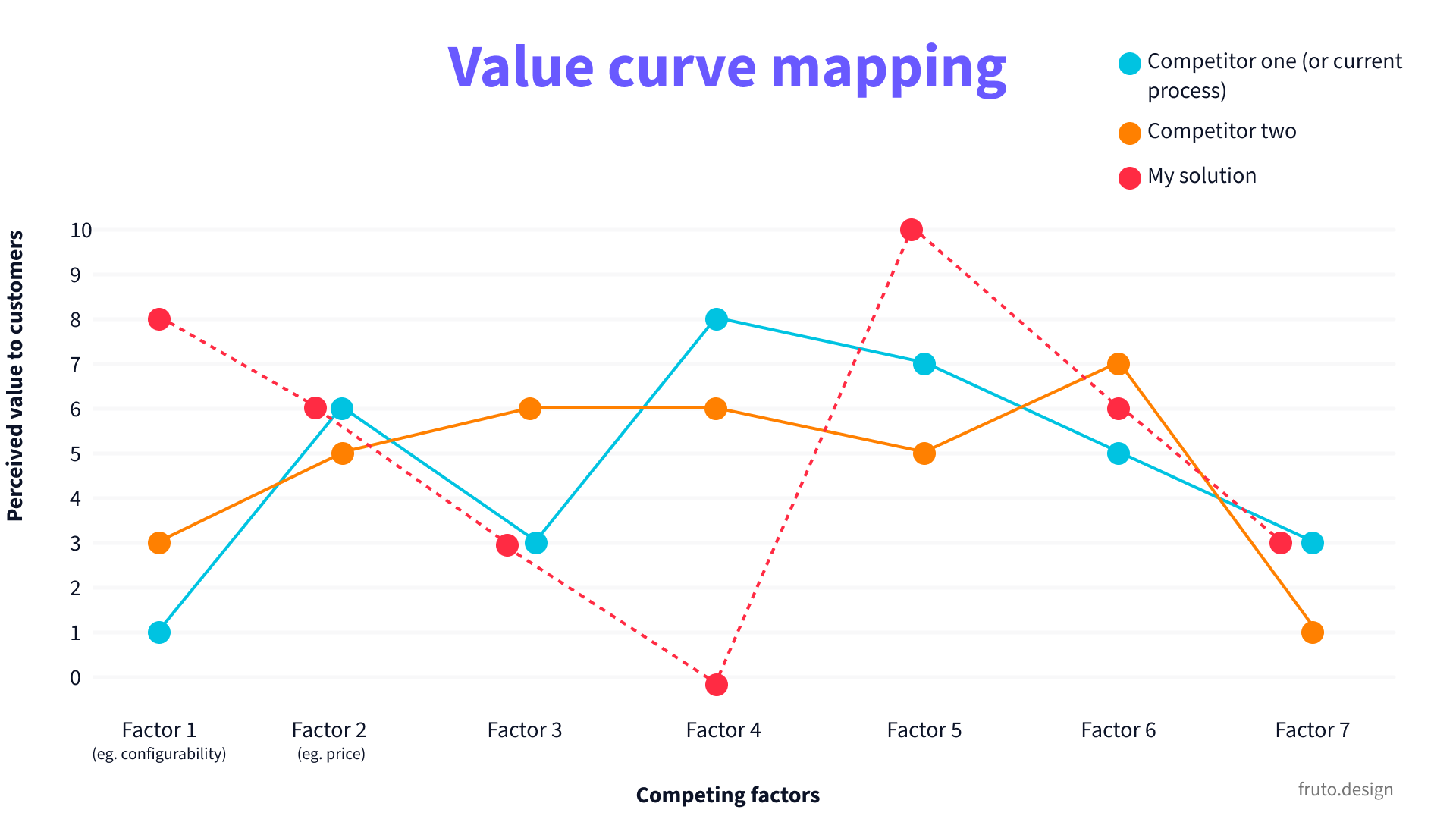
Value curve mapping: What factors of your business, service or product should you increase, decrease, eliminate or create to compete in the market.
By making deliberate choices, raising what customers care about, reducing what adds little value, eliminating what causes friction, and creating entirely new value factors, teams can redefine the playing field rather than competing on the same terms.
This approach is at the core of Blue Ocean Strategy: shifting focus from fighting for market share in a crowded space to creating new demand by offering distinctive, meaningful value.
The value curve mapping provides teams with a shared visual of their current position and future investment opportunities, guiding decisions that balance user needs, business goals, and competitive advantage.
Design with intent
Every element and interaction in a product should serve a clear purpose. That’s what we mean by design with intent: being deliberate about every button, flow, and message, and ensuring that each one exists for a reason that benefits the user and supports the product’s goals.
Intentional design focuses on clarity and usability, ensuring users can easily find, understand, and use the features they need. It’s about crafting information architecture that guides them naturally to the right place, and designing interfaces that feel intuitive from the very first interaction.
Designers achieve this through a combination of craft and insight:
Usability conventions: Leveraging familiar patterns so users don’t have to relearn on every step of the journey.
Design principles: Understanding how people interpret visuals, language, and interactions, and using those cues consistently.
User research: Grounding design decisions in evidence, not assumptions, so that what feels intuitive to us truly works for our users.
When we design with intent, we remove unnecessary friction and create experiences that feel effortless — not because they’re simple, but because they’ve been carefully considered.
Test, iterate, measure
Discovery doesn’t stop once a prototype is built. Through focused research cycles, we continuously test and refine:
Hypothesis card – Define what you believe will improve user outcomes.
Prototype – Visualise the idea quickly and interactively.
Test – Observe real users in action.
Measure – Assess whether it achieved the desired impact.
This continuous loop ensures that design decisions remain evidence-based, not assumption-driven.
Start with discovery, not delivery
The most successful digital products share three habits:
They start with discovery, not delivery.
They design with intent — every decision is purposeful.
They test and iterate regularly to stay aligned with user needs and market shifts.
These are the foundations of competitive advantage.
How Fruto can help
At Fruto, we help product and tech businesses build products that people truly value by bridging the gap between user needs and business goals.
User and customer research: Understand customers deeply through discovery that reveals real needs and opportunities.
Product strategy: Define sharper strategies that align customer value with business growth.
UX design: Create meaningful digital experiences that are intuitive, scalable, and differentiating.
Transformation: Embed UX maturity across teams through workshops, training, and long-term design partnerships.


